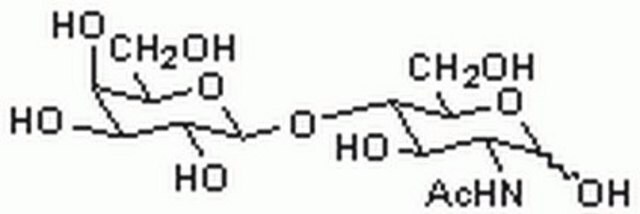A7791
N-Acetyl-D-lactosamine
≥98% (TLC)
Synonym(s):
β-D-Gal-(1→4)-D-GlcNAc, 2-Acetamido-2-deoxy-4-O-β-D-galactopyranosyl-D-glucopyranose, LN, N-Acetyl-4-O-(β-D-galactopyranosyl)-D-glucosamine
About This Item
Recommended Products
Assay
≥98% (TLC)
form
powder
optical activity
[α]25/D 27.5 to 33.5 °, c = 0.5% (w/v) in water
technique(s)
thin layer chromatography (TLC): suitable
impurities
≤8% water
color
white
mp
170 -185 °C ((338 - 365 °F ))
solubility
water: 50 mg/mL, clear to very slightly hazy, colorless to faintly yellow
storage temp.
−20°C
SMILES string
CC(=O)N[C@H]1C(O)O[C@H](CO)[C@@H](O[C@@H]2O[C@H](CO)[C@H](O)[C@H](O)[C@H]2O)[C@@H]1O
InChI
1S/C14H25NO11/c1-4(18)15-7-9(20)12(6(3-17)24-13(7)23)26-14-11(22)10(21)8(19)5(2-16)25-14/h5-14,16-17,19-23H,2-3H2,1H3,(H,15,18)/t5-,6-,7-,8+,9-,10+,11-,12-,13?,14+/m1/s1
InChI key
KFEUJDWYNGMDBV-RPHKZZMBSA-N
Looking for similar products? Visit Product Comparison Guide
Application
Preparation Note
Other Notes
Storage Class Code
11 - Combustible Solids
WGK
WGK 3
Personal Protective Equipment
Certificates of Analysis (COA)
Search for Certificates of Analysis (COA) by entering the products Lot/Batch Number. Lot and Batch Numbers can be found on a product’s label following the words ‘Lot’ or ‘Batch’.
Already Own This Product?
Find documentation for the products that you have recently purchased in the Document Library.
Articles
O-Linked glycoproteins are usually large proteins with a molecular mass of >200 kDa. Glycosylation generally occurs in high-density clusters and may represent as much as 50-80% of the overall mass.
O-Linked glycoproteins are usually large proteins with a molecular mass of >200 kDa. Glycosylation generally occurs in high-density clusters and may represent as much as 50-80% of the overall mass.
O-Linked glycoproteins are usually large proteins with a molecular mass of >200 kDa. Glycosylation generally occurs in high-density clusters and may represent as much as 50-80% of the overall mass.
O-Linked glycoproteins are usually large proteins with a molecular mass of >200 kDa. Glycosylation generally occurs in high-density clusters and may represent as much as 50-80% of the overall mass.
Our team of scientists has experience in all areas of research including Life Science, Material Science, Chemical Synthesis, Chromatography, Analytical and many others.
Contact Technical Service








